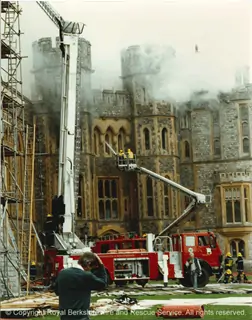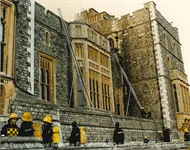Windsor Castle Fire 1992
The Fire

In 1992, Windsor Castle suffered severe damage in a fire, which destroyed some of the most historic parts of the building. Windsor Castle is known as the largest inhabited castle in the world and is one of the official residences of the British monarch, King Charles III.
Royal Berkshire Fire and Rescue Service’s Control room was alerted to a blaze in the Private Chapel at Windsor Castle at 11.37am on Friday 20 November. Five Berkshire appliances and two senior officers were immediately mobilised.
It is believed that the fire was started by a spotlight igniting a curtain. The fire spread rapidly, assisted by the building’s materials and the high level ceiling void of the 185ft St George’s Hall.
A command decision was taken to create fire breaks at the Clock and Chester Towers, and to let the fire to vent through the roof areas in order to prevent further horizontal spread.
End of the Blaze
The blaze was contained and extinguished after many hours of arduous and difficult firefighting, informed by a well-rehearsed strategy. Pre-planning and regular exercising covering the site’s access, water supplies and salvage procedures allowed much of the castle and its contents to be preserved from damage.
Ultimately, 36 pumping appliances, seven specialist units, 25 officers and more than 200 firefighters were deployed before the fire was deemed to be fully under control. Containment was achieved within five hours, but the weight of attack was maintained for a further eight hours before the operations started scaling down.
Use of Resources
At the height of the incident, water from 31 jets and from monitors on two hydraulic platforms with a turntable ladder were used to contain the fire. These were kept supplied by private hydrants in a reservoir, an auxiliary main from the River Thames, a swimming pool and the town’s mains.
Extensive use of breathing apparatus (BA) was also required and it was estimated that 80 BA wearers were at one time deployed simultaneously, with 750 cylinders being used over the duration of the incident. Emergency evacuation procedures had to be adopted twice during the incident because of fears for the safety of crews who were committed inside the building during floor and roof collapses.
Fire crews from London, Surrey, Hampshire, Wiltshire, Oxfordshire, Buckinghamshire and Hampshire joined the response to sustain the weight of attack and maintain fire cover across the county.
After the Fire
Five firefighters were taken to hospital from effects of dealing with the fire, while a further three were treated by Royal Ambulance Service personnel on site.
Extensive salvage work was initiated by castle staff and, under the direction of fire service officers, continued throughout firefighting operations to allow most of the valuable items and irreplaceable artefacts to be removed safely before the roof collapsed in parts of the building.
The Brunswick and Chester Towers, Red, Green and White Drawing Rooms, State Dining Room, Private Chapel, Grand Reception Room and St George’s Hall were all severely damaged in the fire, however the unique Waterloo Chamber and the Ante and Garter Throne Rooms remained virtually undamaged thanks to firefighters’ proficient response to the emergency. In total, more than 100 rooms were said to have been damaged.
The Restoration
A £36.5 million repair project has returned the castle to its former glory, with £15 million-worth of fire prevention equipment added to its defenses to avoid a repeat of the blaze.
